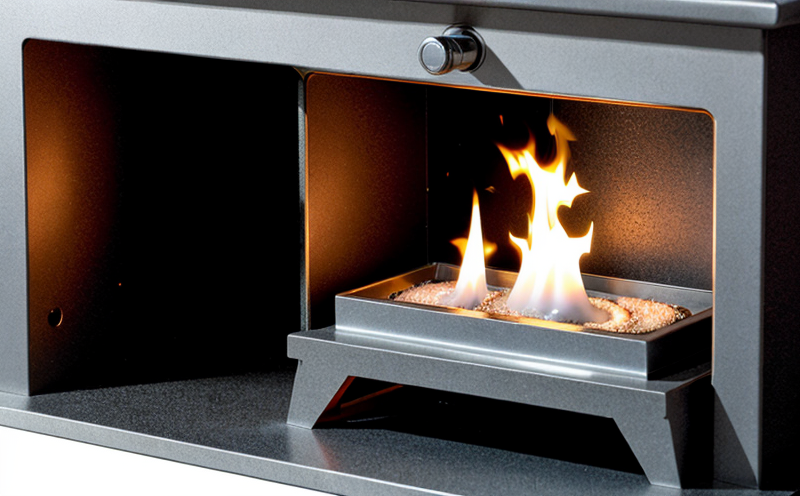Surface Flame Spread Testing of Laboratory Furniture
In fire safety testing, surface flame spread is a critical parameter that measures how quickly flames can travel across the surface of materials. This test is especially important for laboratory furniture as it ensures that in case of a fire, the furniture does not exacerbate the situation by acting as fuel or spreading the fire rapidly. The standard used for this type of testing internationally is ISO 5660-1:2017 and ASTM E84.
The test involves exposing a sample to a controlled flame and measuring the rate at which the flame spreads across its surface, typically over a time period of five minutes or less. The results are expressed in terms of Flame Spread Index (FSI) and Smoke Developed Index (SDI). An FSI value lower than 25 indicates that the material is classified as "non-combustible" according to ASTM E84.
For laboratory furniture, this testing ensures not only compliance with fire safety regulations but also provides peace of mind for those who work in environments where fire hazards are a concern. The furniture used in laboratories often contains flammable chemicals and materials, making it essential that the surfaces do not contribute to the rapid spread of fire.
The surface flame spread test can be performed on various types of laboratory furniture such as benches, cabinets, storage units, and even flooring materials. The process involves selecting a representative sample from each type of furniture, preparing it according to specific guidelines provided by the relevant standards, and then conducting the flame spread test under controlled conditions.
The importance of this testing cannot be overstated in industries that depend heavily on their laboratories for research and development activities. A single piece of laboratory furniture could become a source of significant risk if it fails to meet fire safety standards. By ensuring that all laboratory furniture is tested according to the appropriate standards, organizations can significantly reduce the likelihood of fires spreading within their premises.
The results of these tests are used by quality managers and compliance officers to ensure ongoing adherence to regulatory requirements. For R&D engineers and procurement specialists, this information helps in selecting materials and products that meet the necessary safety standards. It is also crucial for insurers who need to assess potential risks associated with laboratory environments before issuing policies.
Why It Matters
The significance of surface flame spread testing extends beyond mere compliance with regulations; it represents a proactive approach towards enhancing workplace safety and reducing the risk of accidents. In industries where laboratories play a pivotal role, such as pharmaceuticals, biotechnology, and chemical manufacturing, ensuring that laboratory furniture meets fire safety standards is paramount.
- Reduces the risk of fires spreading rapidly within the lab environment,
- Protects valuable equipment from damage due to unexpected incidents,
- Ensures continuity in operations by minimizing downtime caused by emergencies,
- Meets strict regulatory requirements imposed by local authorities and international organizations.
The impact of failing this test can be severe, leading not only to financial losses but also potential harm to personnel. Therefore, investing time and resources into conducting thorough surface flame spread testing is essential for maintaining a safe working environment.
Industry Applications
| Industry | Application |
|---|---|
| Pharmaceuticals | Ensuring compliance with regulations governing fire safety in laboratory environments. |
| Biotechnology | Protecting sensitive research materials from potential fire hazards. |
| Chemical Manufacturing | Maintaining safe work practices that minimize the risk of explosions and fires. |
| Academic Research Institutions | Creating safer spaces for students and researchers while conducting experiments. |
The data provided in this table highlights how surface flame spread testing plays a crucial role across different sectors. By ensuring that laboratory furniture meets the necessary standards, these organizations can enhance safety measures significantly.
- Pharmaceutical companies must adhere to stringent regulations regarding fire safety within their facilities,
- Biotech firms need reliable fire protection systems to safeguard intellectual property and valuable assets,
- In chemical manufacturing plants, preventing fires is critical for maintaining operational efficiency and worker safety,
- Academic institutions aim to provide a secure environment conducive to learning and innovation.
These applications underscore the importance of surface flame spread testing in creating safer environments across various industries.
Quality and Reliability Assurance
- The test ensures that laboratory furniture meets strict fire safety standards,
- It helps identify any weaknesses or vulnerabilities within the materials used,
- By providing consistent results, it builds trust among stakeholders,
- Regular testing allows for continuous improvement of products and processes.
The quality and reliability assurance provided by surface flame spread testing are vital components in maintaining high standards across multiple sectors. This consistency ensures that all parties involved have confidence in the safety measures implemented within laboratory environments.
- Achieving compliance with international standards like ISO 5660-1:2017 and ASTM E84,
- Identifying areas for improvement through detailed analysis of test results,
- Bolstering stakeholder confidence in the safety measures put in place,
- Facilitating ongoing improvements based on feedback from testing processes.
The reliability of these tests contributes significantly to enhancing overall quality assurance practices, ensuring that laboratories operate efficiently and safely.





